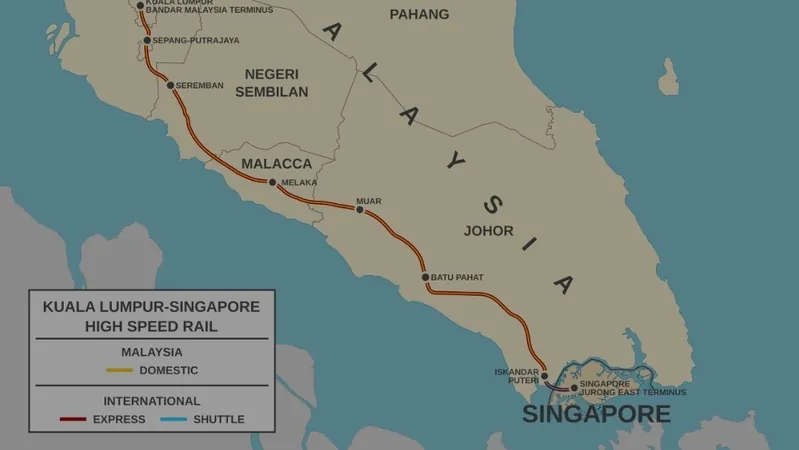
Major Shift in Kuala Lumpur-Singapore HSR Project as MRCB Withdraws: What It Means for the Future of Transport in Southeast Asia
2025-01-01
Author: Mei
MRCB Withdraws from HSR Project
In a stunning move reflecting a strategic pivot towards financial prudence, Malaysian Resources Corporation Bhd (MRCB) has officially pulled out of the Kuala Lumpur-Singapore high-speed rail (HSR) project. This decision comes amid a landscape rife with economic uncertainties and inherent risks tied to ambitious infrastructure endeavors, prompting analysts to view MRCB's withdrawal as a calculated decision rather than an outright retreat.
Background of the HSR Project
Originally, the HSR aimed to enhance regional connectivity with various planned stops throughout Malaysia and Singapore, promising to shorten travel times significantly. However, since its launch in 2013, the project has encountered a tangled web of challenges, including political upheavals and shifting priorities that resulted in substantial delays, including its suspension in 2018 under the Pakatan Harapan government.
Financial and Governance Challenges
Despite these challenges, both nations continue to hold onto the long-term vision of the HSR. However, substantial financial and governance obstacles persist, especially for mega-projects that demand vast upfront investments and sustained commitment. MRCB's exit from this high-stakes consortium, previously led by Berjaya Group, aligns with mounting speculation suggesting that rivals like YTL Construction and SIPP Rail are poised to seize the development contract.
MRCB's Departure Explained
Financial experts interpret MRCB's departure as stemming from rigorous risk assessments designed to protect not only the corporation but also its key stakeholders, such as the Employees Provident Fund and Retirement Fund Inc (KWAP). Analysts argue that remaining involved in the HSR could expose MRCB to considerable unpredictable losses, a sentiment underscored by the project’s troubled history.
Potential Future Roles for MRCB
Although MRCB is stepping back from its leading role in developing the HSR, this doesn’t completely rule out their participation in the broader HSR ecosystem. Industry insiders speculate that MRCB may focus on downstream opportunities like property management, retail ventures, and transit-oriented developments once the project reaches less volatile operational phases.
MRCB's Track Record
Notably, MRCB's past successes—with highlights like the Kuala Lumpur Sentral development—demonstrate its capability to marry urban development with transport systems effectively. Kuala Lumpur Sentral stands as Malaysia’s largest transit hub, showcasing MRCB's expertise and positioning the company as a prime candidate for future collaborations within Malaysia's evolving transportation landscape.
Timeline and Current Consortium
Initially slated for completion in 2026, the HSR was designed to connect vital cities across Malaysia, including Putrajaya, Negeri Sembilan, Melaka, and Johor. However, political and economic climate shifts led to the project’s gradual suspension, culminating in its cancellation in 2018, after which Malaysia compensated Singapore S$102.8 million for incurred preliminary costs.
Remaining Consortium Dynamics
As MRCB withdraws, the remaining consortium now consists of Berjaya Rail Sdn Bhd, Keretapi Tanah Melayu Bhd, IJM Corp Bhd, Deutsche Bahn, Hitachi Rail, and Hyundai Rotem. These entities continue to navigate the complexities of the HSR initiative, looking for feasible development opportunities while addressing the project’s evolving risks.
Implications for Future Projects in Southeast Asia
In the wake of MRCB’s exit, market analysts stress the critical need to balance ambitious infrastructure development with comprehensive risk management—a reality that could influence future projects across Southeast Asia’s transport sector. What does this mean for the future of regional connectivity? Stay tuned as we unpack the implications of this significant shift—and how it could redefine transportation in the region.

 Brasil (PT)
Brasil (PT)
 Canada (EN)
Canada (EN)
 Chile (ES)
Chile (ES)
 Česko (CS)
Česko (CS)
 대한민국 (KO)
대한민국 (KO)
 España (ES)
España (ES)
 France (FR)
France (FR)
 Hong Kong (EN)
Hong Kong (EN)
 Italia (IT)
Italia (IT)
 日本 (JA)
日本 (JA)
 Magyarország (HU)
Magyarország (HU)
 Norge (NO)
Norge (NO)
 Polska (PL)
Polska (PL)
 Schweiz (DE)
Schweiz (DE)
 Singapore (EN)
Singapore (EN)
 Sverige (SV)
Sverige (SV)
 Suomi (FI)
Suomi (FI)
 Türkiye (TR)
Türkiye (TR)
 الإمارات العربية المتحدة (AR)
الإمارات العربية المتحدة (AR)